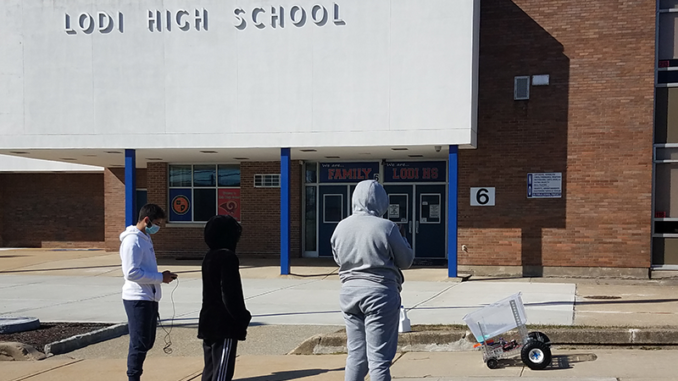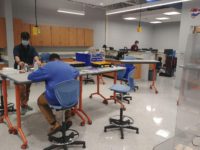
By JENNA CRAIG
Out of the 2.27 square miles that make up Lodi, New Jersey, the local high school robotics club existed in one closet. All of their supplies were stacked and crammed among the shelves. When it was time to meet, they fished out all of their equipment and set up a makeshift lab across several desks in one classroom. In 2019, Lodi High School was granted $5,000 to build a new technology lab, which only opened this past year. Dozens of cabinets and drawers in the new lab remain empty due to lack of supplies. That was until January, 2021.
Errol Bareiss, 24, spent three weeks scrolling through Amazon, debating over high definition monitors, thermal imaging cameras and fancy laser pointers. He picked out everything he wanted, and it totaled up to about $3,000. But he was on a quest to purchase $15,000 worth of equipment and materials for the Lodi High School robotics club.
As a new physics teacher fresh out of his certification program, he wanted to make a difference in kids’ lives. And in December, 2020 when the robotics club made it to the second round of the Samsung Solve for Tomorrow contest, he knew their lives were about to change for the better.
“We actually built a thing, it actually works, and people actually want it,” Bareiss said.
The Samsung Solve for Tomorrow contest challenges middle to high school students across the nation to solve a problem in their community by using science, technology, engineering and mathematics (STEM). Thousands of schools nationwide develop projects that can have a real world impact. From apps that make bus stops safer to making prescription glasses accessible for students, the contest fosters ingenuity. Hundreds and hundreds of schools submit projects each year, meaning that Lodi High’s semifinalist win and $15,000 prize was no easy feat.
Bareiss said the challenge pushed them to a different mode of operation, where “They’re not students working on a project, they’re people trying to solve a problem.” Sidewalks are invaluable to the Lodi community. After winter storms, many paths turn into icy slush. After sifting through ideas, one Lodi student suggested creating a salt-spreading robot that would disperse salt along icy sidewalks and driveways in the winter. The team took the idea and ran with it, creating an invention that goes beyond prototyping.
“We weren’t just making it for the competition,” said Lodi sophomore Eileen Balakrishnan. They were making it for the benefit of their community.
In an effort to launch their project, Bareiss reached out to local officials and the team caught the interest of Rebecca Paladino, the Lodi clean communities coordinator. The students and Paladino agreed that there is inconsistency when it comes to people salting their property. For those that actually salt their driveways and sidewalks, most put down too much salt.
“You only need to put a very light coating before the precipitation starts,” said Paladino in a Zoom call with the team that lasted over and hour. The robot consists of four wheels connected by a metal plate holding the motor that is on a slant. On top is a bin with the salt, and when in use, salt falls through a slot in the bin and a 3D-printed fan tosses it onto the sidewalk.
The contest’s impact on students
A few robotics students had regular meetings each week of the fall 2020 semester to work on the paperwork and start developing a draft of their robot.

Although Bareiss is their advisor, all of the work was solely done by the students. When Lodi High School had to cancel hybrid classes and move to remote learning towards the end of the fall semester, they still met with Bariess virtually. He was allowed to go into the lab, and they instructed him through video calls on what he should do next.
After submitting their proposal and video submission, Bareiss thought, “Great, that was fun, maybe we get this, maybe we don’t.”
Seventy five schools were selected out of thousands of submissions, and this crew earned a spot as semifinalists. Their $15,000 award from Samsung is being put towards new technology for the school’s technology lab.
Below is the video the students filmed, edited and submitted for the contest.
Although they were notified in April that they did not move on to the top 10, the students are still motivated to stay on the project and are excited to use the prize money to purchase better materials. They had the ability to buy whatever they wanted, said Maheen Madhi, a sophomore on the robotics team.
On their wish list is a metal bandsaw, foam carving tools, drawing laptops and a specific type of motor that will upgrade the salt spreader to a larger size with more power. As students in a small-town high school, the prize money means a lot to them because they were unable to fundraise due to COVID-19. “We didn’t have to worry about sacrificing durability,” said Balakrishnan.
Now they can buy what they need for the project and make sure it is of top quality. With the leftover money, Bareiss purchased tools and materials that will last the Lodi robotics club and technology lab for years to come.
Real life applications for Lodi
“It’s perfect for our landscape and our climate here,” said Paladino. During her Zoom meeting with the students, Paladino told them that the borough would be willing to purchase and implement the robot. “I was honored to hear her say that,” said Madhi.
The robot is currently activated via a remote control, but the next goal moving forward is to make it fully autonomous. The students want to write an object detection code so the robot can travel down the sidewalks of Lodi safely.
[AUDIO: Paladino reacts to the idea of a fully autonomous salt-spreading robot]
Should the students take the project to that next level, they would be responsible for reducing the need for man power that Lodi is already lacking, helping elderly and disabled citizens maintain their property, and ensuring that Lodi’s sidewalks are effectively salted.
Paladino pointed out how the salt-spreader could also be used for other materials and purposes, such as refiling the school turf field or as an easy way to fertilize yards. Balakrishnan said that once winter was over, they were unable to test the robot’s efficacy in clearing snow, but during the warmer seasons, the team is going to start experimenting with seeds and fertilizer.
What started as a simple contest has evolved into a real, hands-on STEM experience for these students with the potential to directly benefit the borough of Lodi. Combining community service and science, these students have instituted new reputation at Lodi High School, and hopefully their success will draw more students to the robotics club and foster more interest in STEM.
This unique experience has also helped enrich the students’ education in preparation for careers in STEM; Balakrishnan wants to study industrial design and Madhi wants to study aerospace design.
“With this program, we are skyrocketing them ahead,” said Bareiss.

Leave a Reply
You must be logged in to post a comment.